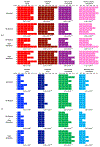Contractile performance of the Alaska blackfish (Dallia pectoralis) ventricle: Assessment of the effects of temperature, pacing frequency, the role of the sarcoplasmic reticulum in contraction and adrenergic stimulation
- PMID: 31493554
- PMCID: PMC6824994
- DOI: 10.1016/j.cbpa.2019.110564
Contractile performance of the Alaska blackfish (Dallia pectoralis) ventricle: Assessment of the effects of temperature, pacing frequency, the role of the sarcoplasmic reticulum in contraction and adrenergic stimulation
Abstract
The air-breathing Alaska blackfish (Dallia pectoralis) experiences aquatic hypoxia, but restricted air-access in winter due to ice-cover. To lend insight into its overwintering strategy, we examined the effects of thermal acclimation (15 °C vs. 5 °C), acute temperature change (to 10 °C), increased pacing frequency, inhibition of sarcoplasmic reticulum (SR) Ca2+ release and uptake and adrenaline (1000 nmol l-1) on the contractile performance of isometrically-contracting, electrically-paced ventricular strips. At routine pacing frequencies, maximal developed force (Fmax) was equivalent at 5 °C (2.1 ± 0.2 mN mm-2) and 15 °C (2.2 ± 0.3 mN mm-2), whereas contraction durations were 2.2- to 2.4-times longer and contraction rates 2.4- to 3.5-times slower at 5 °C. Maximum contraction frequency was reduced by decreased temperature, being 0.91 ± 0.04 Hz at 15 °C, 0.35 ± 0.02 Hz at 5 °C and equivalent between acclimation groups at 10 °C (~0.8 Hz). 15 °C and 5 °C strips were insensitive to SR inhibition at routine stimulation frequencies, but SR function supported high contraction rates at 10 °C and 15 °C. Adrenaline shortened T0.5R and increased relaxation rate by 18-40% at 15 °C, whereas at 5 °C, adrenaline augmented Fmax by 15-25%, in addition to increasing contraction kinetics by 22-82% and decreasing contraction duration by 20%. Overall, the results reveal that ventricular contractility is suppressed in cold-acclimated Alaska blackfish largely by acute and perhaps direct effects of decreased temperature, which effectively preconditions the tissue for low energy supply during winter hypoxia. Additionally, the level of cardiac performance associated with maintained activity in winter is supported by enhanced inotropic responsiveness to adrenaline at 5 °C.
Keywords: Adrenaline; Cardiac; Force-frequency; Heart; Ryanodine; Sarcoplasmic reticulum; Temperature; Thapsigargin.
Copyright © 2019 Elsevier Inc. All rights reserved.
Conflict of interest statement
Conflict of Interest
The authors declare no competing interests.
Figures








Similar articles
-
The air-breathing Alaska blackfish (Dallia pectoralis) remodels ventricular Ca2+ cycling with chronic hypoxic submergence to maintain ventricular contractility.Curr Res Physiol. 2022 Jan 10;5:25-35. doi: 10.1016/j.crphys.2022.01.001. eCollection 2022. Curr Res Physiol. 2022. PMID: 35072107 Free PMC article.
-
Importance of the sarcoplasmic reticulum and adrenergic stimulation on the cardiac contractility of the neotropical teleost Synbranchus marmoratus under different thermal conditions.J Comp Physiol B. 2007 Oct;177(7):713-21. doi: 10.1007/s00360-007-0166-3. Epub 2007 Jun 12. J Comp Physiol B. 2007. PMID: 17562053
-
The effect of temperature and adrenaline on the relative importance of the sarcoplasmic reticulum in contributing Ca2+ to force development in isolated ventricular trabeculae from rainbow trout.J Exp Biol. 1997;200(Pt 11):1607-21. doi: 10.1242/jeb.200.11.1607. J Exp Biol. 1997. PMID: 9319512
-
Regulation of cardiac contractility in a cold stenothermal fish, the burbot Lota lota L.J Exp Biol. 2002 Jun;205(Pt 11):1597-606. doi: 10.1242/jeb.205.11.1597. J Exp Biol. 2002. PMID: 12000804
-
Air breathing in the Arctic: influence of temperature, hypoxia, activity and restricted air access on respiratory physiology of the Alaska blackfish Dallia pectoralis.J Exp Biol. 2014 Dec 15;217(Pt 24):4387-98. doi: 10.1242/jeb.105023. Epub 2014 Nov 13. J Exp Biol. 2014. PMID: 25394628 Free PMC article.
Cited by
-
Does the ventricle limit cardiac contraction rate in the anoxic turtle (Trachemys scripta)? I. Comparison of the intrinsic contractile responses of cardiac chambers to the extracellular changes that accompany prolonged anoxia exposure.Curr Res Physiol. 2022 Jul 12;5:312-326. doi: 10.1016/j.crphys.2022.07.001. eCollection 2022. Curr Res Physiol. 2022. PMID: 35872835 Free PMC article.
-
Indirect evidence that anoxia exposure and cold acclimation alter transarcolemmal Ca2+ flux in the cardiac pacemaker, right atrium and ventricle of the red-eared slider turtle (Trachemys scripta).Comp Biochem Physiol A Mol Integr Physiol. 2021 Nov;261:111043. doi: 10.1016/j.cbpa.2021.111043. Epub 2021 Jul 29. Comp Biochem Physiol A Mol Integr Physiol. 2021. PMID: 34332046 Free PMC article.
-
Cardiophysiological responses of the air-breathing Alaska blackfish to cold acclimation and chronic hypoxic submergence at 5°C.J Exp Biol. 2020 Nov 16;223(Pt 22):jeb225730. doi: 10.1242/jeb.225730. J Exp Biol. 2020. PMID: 33020178 Free PMC article.
-
The air-breathing Alaska blackfish (Dallia pectoralis) remodels ventricular Ca2+ cycling with chronic hypoxic submergence to maintain ventricular contractility.Curr Res Physiol. 2022 Jan 10;5:25-35. doi: 10.1016/j.crphys.2022.01.001. eCollection 2022. Curr Res Physiol. 2022. PMID: 35072107 Free PMC article.
References
-
- Abramochkin DV, Vornanen M, 2015. Seasonal acclimatization of the cardiac potassium currents (IK1 and IKr) in an arctic marine teleost, the navaga cod (Eleginus navaga). J. Comp. Physiol. B 185, 883–890. - PubMed
-
- Aho E, Vornanen M, 1999. Contractile properties of atrial and ventricular myocardium of the heart of rainbow trout Oncorhynchus mykiss: Effects of thermal acclimation. J. Exp. Biol 202, 2663–2677. - PubMed
-
- Aho E, Vornanen M, 2001. Cold acclimation increases basal heart rate but decreases its thermal tolerance in rainbow trout (Oncorhynchus mykiss). J. Comp. Phyisol. B 171, 173–179. - PubMed
-
- Birkedal R, Shiels HA, 2007. High [Na+]i in cardiomyocytes from rainbow trout. Am. J. Phys. Regul. Integr. Comp. Phys 293, R861–R866. - PubMed
-
- Campbell MA, Lopéz JA, 2014. Mitochondrial phylogeography of a Beringian relict: the endemic freshwater genus of blackfish Dallia (Esociformes). J. Fish Biol. 84, 523–538. - PubMed
Publication types
MeSH terms
Substances
Grants and funding
LinkOut - more resources
Full Text Sources
Research Materials
Miscellaneous

